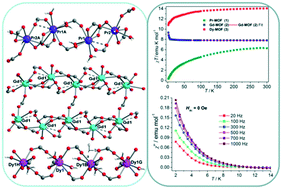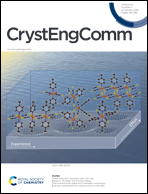Three 3D LnIII-MOFs based on a nitro-functionalized biphenyltricarboxylate ligand: syntheses, structures, and magnetic properties†
Abstract
Three 3D lanthanide metal–organic frameworks (Ln-MOFs), [Pr4(L)4(H2O)8]·10H2O (1), [Gd(L)(CH3COOH)0.5]·0.5H2O (2), and [Dy(L)(H2O)2]·H2O (3), H3L = biphenyl-3′-nitro-3,4′,5-tricarboxylic acid, have been synthesized by solvothermal methods and their structures and magnetic properties were fully characterized. The Pr-MOF (1) contains unique linear-like tetranuclear clusters with triple and double carboxylate bridges. The tetranuclear clusters are cross-linked by L backbones to form a 3D framework, and it represents a rare (3,3,12)-connected net with the point symbol (43)(43)(421·625·818·102). The Gd-MOF (2) is a layer-pillared 3D framework in which the layers with (μ-COO)2(μ2-Ocarboxylate) triple bridges and single carboxylate bridges are interlinked by the L ligands. The Dy-MOF (3) is constructed from 1D uniform chain units with (μ-COO)2 double bridges. Adjacent chains are connected by the L ligands into a 3D framework. Magnetic investigations on these MOFs have been carried out and revealed that the different carboxylate bridges are antiferromagnetic in the Pr-MOF (1) and Dy-MOF (3) but ferromagnetic in the Gd-MOF (2). Furthermore, the Dy-MOF (3) also shows slow magnetic relaxation behaviors under a zero dc field.



 Please wait while we load your content...
Please wait while we load your content...